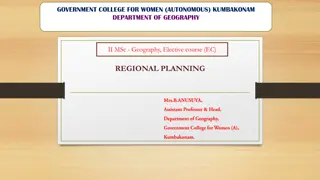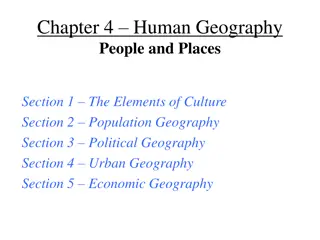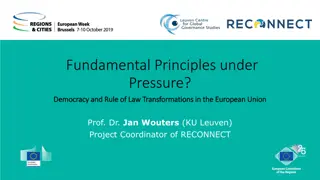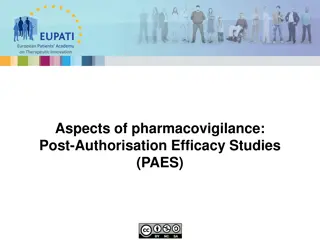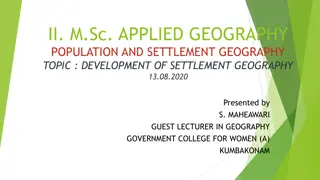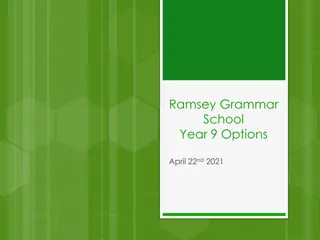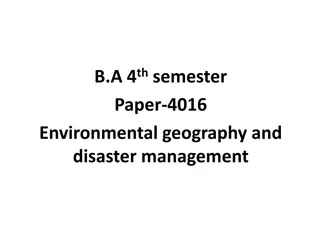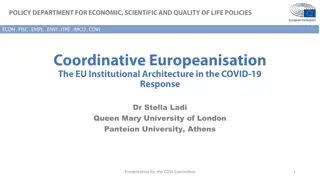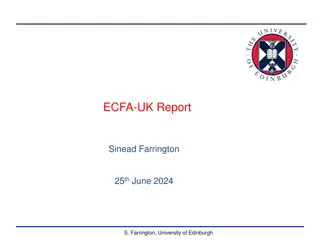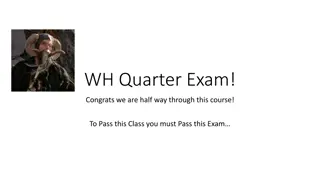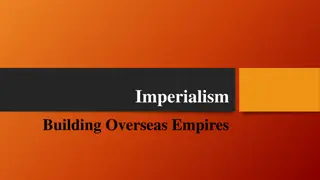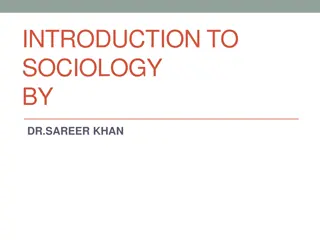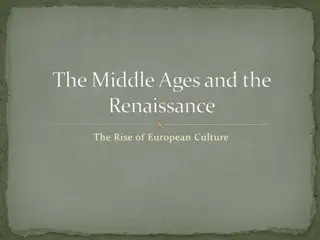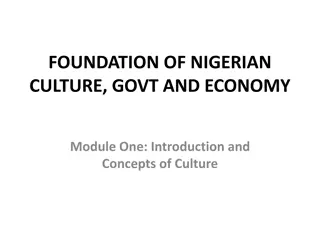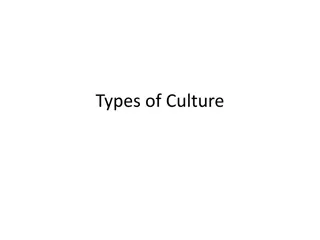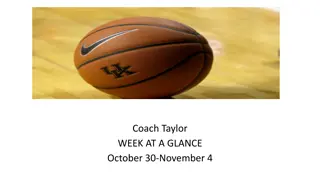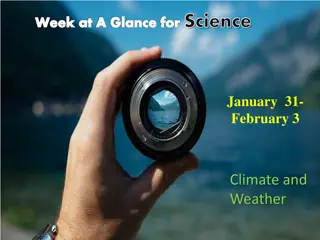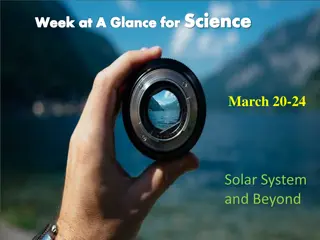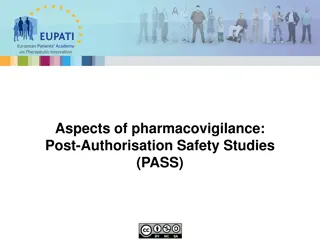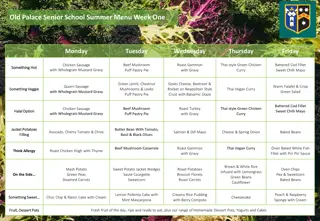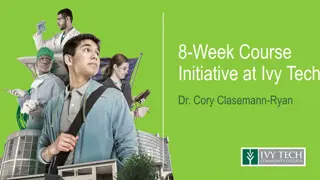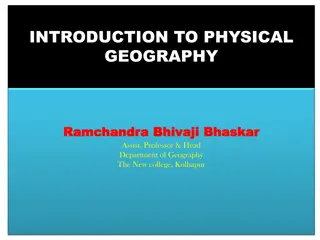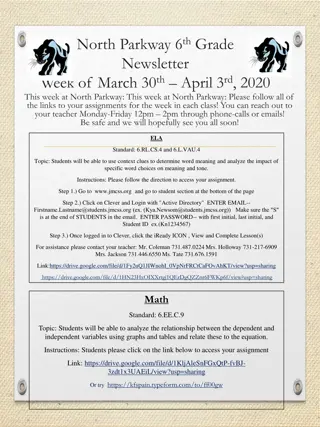European Geography and Culture Studies Week at a Glance
Explore the diverse features of Europe through this week's Social Studies lessons focusing on locating geographical landmarks, understanding environmental issues, and delving into cultural characteristics. The activities include map studies, research, and discussions to deepen understanding of this fascinating region.
Download Presentation

Please find below an Image/Link to download the presentation.
The content on the website is provided AS IS for your information and personal use only. It may not be sold, licensed, or shared on other websites without obtaining consent from the author. Download presentation by click this link. If you encounter any issues during the download, it is possible that the publisher has removed the file from their server.
E N D
Presentation Transcript
Week at a Glance for Social Studies August 22-26
SS6G7 Locate selected features of Europe. a. Locate on a world and regional political-physical map: the Danube River, Rhine River, English Channel, Mediterranean Sea, European Plain, the Alps, Pyrenees, Ural Mountains, and Iberian Peninsula. b. Locate on a world and regional political-physical map the countries of France, Germany, Italy, Russia, Spain, Ukraine, and United Kingdom. SS6G8 Explain environmental issues in Europe. a. Explain the causes and effects of acid rain in Germany. b. Explain the causes and effects of air pollution in the United Kingdom. c. Explain the causes and effects of the nuclear disaster in Chernobyl, Ukraine. SS6G10 Describe selected cultural characteristics of Europe. a. Describe the diversity of languages spoken within Europe. b. Identify the major religions in Europe: Judaism, Christianity, and Islam.
locate on a world and regional political- physical map the countries of France, Germany, Italy, Russia, Spain, Ukraine, and United Kingdom.
Locate on a world and regional political-physical map: the Danube River, Rhine River, English Channel, Mediterranean Sea, European Plain, the Alps, Pyrenees, Ural Mountains, and Iberian Peninsula.
Monday, August 22 Standard: SS6G7 Locate selected features of Europe. Learning Target: I can locate select features of Europe. Warm-up: Silent Reading (Scholastic Magazine). Work Session: Direct Instruction; students will take notes and view maps of Europe; Brain Wrinkle. Closing: Think-pair- Share Reminders: Quiz on Friday
Tuesday, August 23 Standard: SS6G7 Locate selected features of Europe. Learning Target: I can locate select features of Europe. Warm-up: Silent Reading (Scholastic Magazine). Work Session: Students will work on Study Guide with partner; Board Game; Video; Brain Wrinkles Closing: Teacher Summary Reminders: Quiz on Friday
Wednesday, August 24 Standard: SS6G7 Locate selected features of Europe. Learning Target: I can locate select features of Europe. Warm-up: Color Code Europe Map; Trace each county separately Work Session: Guided Instruction; students will research each country and physical feature (flip book or graphic organizer); Introduce Environmental Issues and major religion; Brain Wrinkle Closing: Think-pair- Share Reminders: Quiz on Friday
Thursday, August 25 Standard: SS6G7 Locate selected features of Europe. Learning Target: I can locate select features of Europe. Warm-up: Color Code Europe Map; Trace each county separately Work Session: Video; Class review of Map Study Guide; Environmental Issues and major religion; Board Game; Brain Wrinkle Closing: Ticket out the Door Reminders: Quiz on Friday
Friday, August 26 Standard: SS6G7 Locate selected features of Europe. Learning Target: I can locate select features of Europe. Warm-up: Silent Reading (Library Book). Work Session: Make a Virtual Field Trip for SSG7, G8, G10 Closing: Think-pair- Share Reminders: Quiz on Friday
Resources for Unit 1: Europe Countries of Europe Physical Geography of Europe Part 1- Landforms and Waterways 17 Most Beautiful Countries in Europe Travel Video
Social Studies Standards SS6H3 Explain conflict and change in Europe. a. Describe the aftermath of World War I: the rise of communism, the Treaty of Versailles, the rise of Nazism, and worldwide depression. SS6G7 Locate selected features of Europe. a. Locate on a world and regional political-physical map: the Danube River, Rhine River, English Channel, Mediterranean Sea, European Plain, the Alps, Pyrenees, Ural Mountains, and Iberian Peninsula. b. Locate on a world and regional political-physical map the countries of France, Germany, Italy, Russia, Spain, Ukraine, and United Kingdom. SS6G8 Explain environmental issues in Europe. a. Explain the causes and effects of acid rain in Germany. b. Explain the causes and effects of air pollution in the United Kingdom. c. Explain the causes and effects of the nuclear disaster in Chernobyl, Ukraine. SS6G9 Explain the impact of location, climate, natural resources, and population distribution on Europe. a. Compare how the location, climate, and natural resources of Germany, the United Kingdom and Russia impact trade and affect where people live. SS6G10 Describe selected cultural characteristics of Europe. a. Describe the diversity of languages spoken within Europe. b. Identify the major religions in Europe: Judaism, Christianity, and Islam. SS6CG3 Compare and contrast various forms of government. a. Explain citizen participation in autocratic and democratic governments. [i.e., role of citizens in choosing the leaders of the United Kingdom (parliamentary democracy), Germany (parliamentary democracy), and Russia (presidential democracy)]. b. Describe the two predominant forms of democratic governments: parliamentary and presidential. SS6E7 Analyze different economic systems. a. Compare how traditional, command, and market economies answer the economic questions of 1-what to produce, 2-how to produce, and 3-for whom to produce. b. Explain that countries have a mixed economic system located on a continuum between pure market and pure command. c. Compare the basic types of economic systems found in the United Kingdom, Germany, and Russia.
SS6E8 Analyze the benefits of and barriers to voluntary trade in Europe. a. Explain how specialization encourages trade between countries. b. Compare and contrast different types of trade barriers such as tariffs, quotas, and embargoes. c. Explain why international trade requires a system for exchanging currencies between nations. d. Describe the purpose of the European Union and the relationship between member nations. SS6E9 Describe factors that influence economic growth and examine their presence or absence in the United Kingdom, Germany, and Russia. a. Evaluate how literacy rates affect the standard of living. b. Explain the relationship between investment in human capital goods (education and training) and gross domestic product (GDP per capita). c. Explain the relationship between investment in capital (factories, machinery, and technology) and gross domestic product (GDP per capita). d. Describe the role of natural resources in a country s economy. e. Describe the role of entrepreneurship.


